Kue
|
Jajan pasar (market munchies) in Java, consist of assorted kue. | |
| Alternative names | Kueh (Hokkian), Kuih (Malaysia) |
|---|---|
| Course | Snack |
| Place of origin | Indonesia |
| Main ingredients | Various traditional snacks |
|
| |
Kue is an Indonesian bite-sized snack or dessert food. Kue is a fairly broad term in Indonesian to describe a wide variety of snacks; cakes, cookies, fritters, pies, scones, and patisserie.[1] Kue are popular snacks in Indonesia, which has the largest variety of kue. Because of their historical colonial ties, kue is also popular in the Netherlands.
Indonesian kue demonstrated local native delicacies, Chinese and Indian influences, as well as European cake and pastry influences. For example, bakpia and kue ku are Chinese Peranakan origin, kue putu is derived from Indian puttu, while kue bugis, klepon, nagasari, getuk, lupis and wajik are native origin, on the other hand lapis legit, kue cubit, kastengel, risoles and pastel are European influenced. In Java, traditional kues are categorized under jajan pasar (lit: "market buys" or "market munchies"). The well-set and nicely decorated colourful assorted jajan pasar usually served as food gift, parcel or to accompany tumpeng (the main dish) during Javanese traditional ceremonies
Etymology
The term "kue" was derived from Hokkian: kueh or kway; from Hokkien: 粿 koé. It is also spelled as kuih in Malaysian, and kueh in Singapore. Kue are more often steamed than baked, and are thus very different in texture, flavour and appearance from Western cakes or puff pastries. Many kue are sweet, but some are savoury.
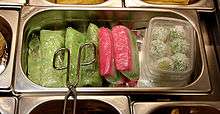
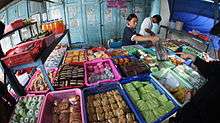
Indonesian kues are usually categorized according to its moisture. Roughly divided under two groups, kue basah (lit: "wet kue") and kue kering (lit: "dry kue"). In fact, the word kue in Indonesian language is used to refer to not only these kinds of traditional snack, but also all types of cake and some types of pastries. Most kue kering are technically pastries and many Western cakes can be considered as kue basah.
Kue basah
Most of traditional Indonesian kues are kue basah (wet kue). Most are moist and soft in texture, steamed or fried instead of baked. Kue basah usually have rich coconut milk, sugar and rice flour content, and rather moist; as the result it can not last for more than a day or two, especially in hot and humid Indonesian tropical climate, in contrast to kue kering that might last longer. The examples of kue basah are:
- Kue ape, thin wheat flour batter pancake with thicker part on the middle, colloquially called kue tetek (breast cake).
- Kue apem, similar to Malay apam which ultimately derived from Indian appam. It is made of cassava tapai, coconut water, coconut sugar, rice flour, coconut milk, all mixed as a dough mixture and steamed until fluffy and cooked. Served with grated coconut.
- Kue bakpia, bean-filled Chinese pastry originally introduced by Fujianese immigrants. Today associated with Yogyakarta city.
- Kue bika Ambon, yellow porous cake made from tapioca and sago flour, eggs, sugar and coconut milk. Bika Ambon generally sold in pandan flavour, although now available also other flavors like banana, durian, cheese, chocolate.
- Kue bingka, cake made of mashed potato, flour, eggs, sugar, coconut milk, vanilla, milk and margarine, all mixed as dough and baked until golden brown and cooked. probably related to Philippines bibingka cake.
- Kue bolen, baked pastry with crust layers similar to those of croissant, baked flour with butter or margarine layers, filled with cheese and banana. Other variants uses durian fillings. The cake demonstrate European pastry influences.
- Kue bolu kukus, steamed bun made of flour, sugar, eggs, margarine, and vanilla or chocolate flavouring.
- Kue bugis, steamed glutinous rice flour and tapioca colored green with pandan, filled with grated coconut and coconut sugar, wrapped inside banana leaf.
- Kue cara bikang
- Kue cubit, Kue cubit uses flour, baking powder, sugar and milk as their primary ingredients. The liquid dough is poured inside a steel plate with several small round basins so that it will form round shape when cooked, and poured with meises (chocolate granules not unlike sprinkles) on top of it. The seller uses some kind of special hooked stick to take the cake off from the steel plate. This cake is called kue "cubit" (Indonesian: pinch) because of its small bite size, to eat it one have to pinch it.
- Kue clorot, the sticky dough of glutinous rice flour sweetened with coconut sugar filled into the cone-shaped janur (young coconut leaf), and steamed until cooked.
- Kue cucur, pancake made of fried rice flour batter and coconut sugar.
- Kue dadar gulung, grated coconut with coconut sugar wrapped inside thin omelette made of rice flour. The dadar (omelette) usually colored green.
- Kue gemblong, made of glutinous rice flour formed into a ball, deep fried and then coated with palm sugar.
- Kue getuk, made of cassava flour and coconut sugar, served with sweetened grated coconut
- Kue klappertaart, coconut tart, specialty of Manado city, North Sulawesi.
- Kue klepon, balls of glutinous rice flour filled with gula jawa (red coconut sugar), boiled or steamed. The balls are rolled upon grated coconut as the coconut granules stuck upon the balls. It is called "onde-onde" in Sumatra and Malay Peninsula
- Kue kroket, Indonesian version of potato croquette, introduced during the Dutch colonial rule. The kroket is made of potato and minced chicken inside a crepe-like wrapper is one of the popular snack items in Indonesia. The kroket is made by taking a potato and chicken filling and wrapping it inside a crepe-like wrapper, breaded, and fried.
- Kue ku, Chinese origin kue of sticky rice flour with sweet filling. The same as Chinese "Ang ku kueh" (Red Tortoise Cake).
- Kue lapis, layered colorful cake made of glutinous rice flour, coconut and sugar
- Kue lapis legit, also known as Kue lapis Batavia or spekkoek (layer cake) is a rich kue consisting of thin alternating layers made of butter, eggs and sugar, piled on top of each other. Each layer is laid down and then grilled separately, making the creation of a kueh lapis an extremely laborious and time-consuming process.
- Kue lapis Surabaya, similar ingredient to lapis legit but only have three layers of plain and chocolate flavour layered cake.
- Kue lemper, made of glutinous rice filled with chicken, fish or abon (meat floss). The meat filling is rolled inside the rice, in a fashion similar to an egg roll.
- Kue lupis, compressed glutinous rice served with grated coconut and coconut sugar syrup.
- Kue mangkok Indonesian traditional cupcake, usually sweetened with palm sugar or tapai (fermented cassava).
- Kue moci, the same recipe and derived from Japanese mochi, glutinous pounded rice flour filled with sweet peanut paste. Some variant covered with sesame seeds, other might be plain.
- Kue nagasari or kue pisang, traditional steamed cake made from rice flour, coconut milk and sugar, filled with slices of banana.
- Kue odading
- Kue onde-onde, the same as Chinese Jin deui. In Sumatra and Malay Peninsula, onde-onde refer to klepon.
- Kue ongol-ongol
- Kue pancong
- Kue pandan, fluffy cake made of eggs, sugar, and flour, flavoured with Pandanus extract, usually colored light green.
- Kue pastel, pie of crust made of thin pastry filled with meat (usually chicken) mixed with vegetables (chopped carrot and beans), rice vermicelli and sometimes egg, then deep-fried in vegetable oil. It is thought to be of Portuguese origin. Its shape is similar to Malaysian karipap (curry puff) but curry paste/powder is absent.
- Kue pisang molen, fried banana wrapped in stripe of wheat flour dough. The term molen refer to "mill" in Dutch, suggested its Dutch influence.
- Kue poffertjes, Dutch batter pancakes, demonstrate Dutch influences on Indonesian cuisine.
- Kue pukis
- Kue putu, rice flour with green pandan leaf coloring, cooked with palm sugar filling, steamed in bamboo pipes, and served with grated coconut.
- Kue putu ayu
- Kue putu mayang
- Kue rangi
- Kue risoles, a mixture of minced meat, beans and carrots wrapped inside thin flour omelette, covered with bread crumbs and fried.
- Kue semar mendem, variants of lemper, instead wrapped with banana leaf, the glutinous rice filled with chicken, fish or meat floss is wrapped inside thin egg omelette.
- Kue serabi, traditional pancake that is made from rice flour with coconut milk or just plain shredded coconut as an emulsifier.
- Kue sus or soes, a baked pastry filled with soft and moist cream made from the mixture of milk, sugar and flour.
- Kue talam
- Kue wajik, a diamond-shaped compressed sweet glutinous rice cake.
- Kue wingko, a traditional Javanese pancake-like snack made from coconut.
Kue kering
In Indonesian language kue kering (dried kue) is identical to cookies, both traditional or western derived. Some variant, especially kaasstengels clearly demonstrate Dutch origin (kaas is Dutch word for cheese). Because it is dried, it last longer than kue basah. Kue kering often served during annual holidays and important festivities, popular to be offered for visiting guests during Lebaran and Natal. Examples of kue kering are:
- Kue akar kelapa
- Kue bangkit
- Kue bola keju
- Kue cistik (kue cheese stick)
- Kue durian renyah
- Kue gapit
- Kue jahe
- Kue keju suiker
- Kue lidah kucing
- Kue nastar
- Kue nastar cengkeh
- Kue nastar keju
- Kue nastar lemon
- Kue Kaasstengels, cheese cookie
- Kue kacang sabit
- Kue keping coklat, choco chip cookie
- Kue kering coklat
- Kue keciput (kue buah rotan)
- Kue kelapa
- Kue kopi kelapa
- Kue kurma
- Kue kuping gajah
- Kue lanting
- Kue putri salju, cookies coated with white powdered sugar
- Kue semprong, cone shaped crispy flour and sugar thin layer
- Kue sagu
- Kue sagu keju
- Kue satu or kue koya
- Kue sus kering keju
- Kue tambang
- Kue telur gabus
Gallery
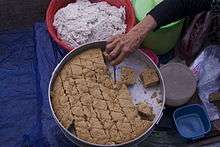

- Kue bagea kenari
- Kue bangkit
- Kue bika Ambon
 Kue carabikang
Kue carabikang- Kue cenil
 Kue clorot atau cerorot
Kue clorot atau cerorot
- Kue dadar gulung
- Kue nagasari
- Kue klepon
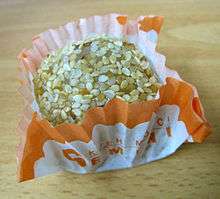 Kue moci
Kue moci Kue moho
Kue moho- Kue putu mayang
 Kue pukis
Kue pukis Lapis legit and kue lapis
Lapis legit and kue lapis Kue lapis Surabaya
Kue lapis Surabaya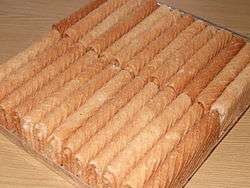 Kue semprong
Kue semprong- Kue ku, derived from Chinese Ang Ku Kueh
- Kue lumpang
- Kue lumpur surga
 Kue ongol-ongol
Kue ongol-ongol- Kue risoles
- Kue pastel
 Kue wingko babad
Kue wingko babad
See also
| Wikimedia Commons has media related to Kue. |

